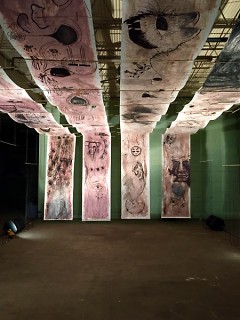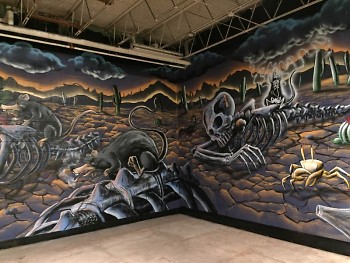“This place doesn’t feel like ArtPrize. And it’s awesome.”
This was overheard on Sunday afternoon during the artist reception for the Cultura Collective, the group of creatives that took over the space at 912 Grandville Ave. for ArtPrize 8. Since the space has been open, neighborhood children and families visit the space and return the next day to experience it again. Residents who have seen other ArtPrize projects manifesting around them in their neighborhood now see their own projects manifesting as well.
This is the work of the Cultura Collective, and what we hope is the beginning of a conversation on how to engage people with authenticity, encourage people to start thinking differently, and take a closer look at the experiences of people who are being directly affected by current issues.
While conversations about race, development, gentrification, and art are simultaneously happening all over our city, this group of local and neighborhood artists banded together to empower each other and hold up a different narrative. A narrative of identity and solidarity, in a warehouse space at 912 Grandville Avenue in the heart of the vibrant Roosevelt Park neighborhood.
The site is being used to explore themes of race, cultural identity, and personal experience as the exhibition "This Space Is Not Abandoned." In Grand Rapids, spaces driven by and for people of color are often approached with layers of assumption, social fear, and stereotypes that place people into a box that is frequently held up as “ethnic” or “exotic.” "This Space Is Not Abandoned" seeks to overcome these assumptions through the vehicles of expansive murals, paintings, photographs, multi-media installation, fashion, dance, and theater. Community members now own the space, create freely, and hold up one another’s cultures, identities, and visions, inviting viewers to learn more about artists who live and work locally; who they are as creators and as people.
A mural created by the Cook Arts Center Teen Leaders and the Hispanic Center of West Michigan SOL Peer Leaders covers the north wall of the building where visitors enter. Piper Adonya’s Queens are on display with Eve, the final part of her mixed media portrait series. Andre Daley’s recorded conversations about racial equity in Grand Rapids allow visitors to listen to their neighbors' perspectives and then record their own part of the conversation. George Eberhardt and David Frison have unveiled new murals that transform the interior of the warehouse. Noemi Gonzalez is showing a series of photographs that explore how people and objects carry history and identity with them. Ricardo Gonzalez promotes the space with bold statements of neighborhood pride and culture in the recognizable format of supermercado signs lined along the fence. Nancy Quero uses modern Mexican fashion to display 16 different dresses from Guelaguetza Design’s Oaxaca y sus Regiones series. Colby Roanhorse plays with draped drawings on long rolls of paper, while viewers hear different music recalling a fable from his childhood. Alejandro Ruiz also recalls memories from his childhood translated through painted symbols on concrete. Abstract and colorful digital drawings by Javier Torres will be on display on the exterior of the building, inviting people into the space. In addition to these visual and audio elements, there will be performances by local hip-hop group The Great Ones, dancers from Vizions Dance coordinated by Yesenia Gomez, and Ebony Road Players’ recent production of A Simple Question, produced by Edye Hyde.
During a time when the entire city is growing, in competition and undergoing cultural upheaval in its attempt for relevance to the contemporary art world, the work of the Cultura Collective is an ambitious symbol of local solidarity, rather than a token of diversity.
Throughout the past decade support has emerged for creative placemaking, which encourages leaders to use art in community planning and development projects, intending to revitalize abandoned spaces, stimulate local economies and improve public safety. The exhibit at 912 Grandville welcomes viewers to think critically about what it really means to “make a place,” and for whom these places are being made. What impact does art have on the different communities in a segregated city, and how can it be kept accessible for all art-makers and viewers throughout the year? Is there a real commitment to identifying and reinforcing the identity of an existing community when revitalizing spaces that are not abandoned?
The venue is open until October 9, 2016, Monday -Thursday from 5 p.m.- 8 p.m., Fridays and Saturdays from 12 p.m.- 8 p.m. and Sundays from 12 p.m. - 6 p.m.. Performances are held at varying times Friday's through Sunday's and Tuesday's. Check www.culturacollective.com or the Cultura Collective Facebook page for more information.
The Rapidian, a program of the 501(c)3 nonprofit Community Media Center, relies on the community’s support to help cover the cost of training reporters and publishing content.
We need your help.
If each of our readers and content creators who values this community platform help support its creation and maintenance, The Rapidian can continue to educate and facilitate a conversation around issues for years to come.
Please support The Rapidian and make a contribution today.


